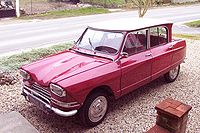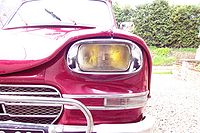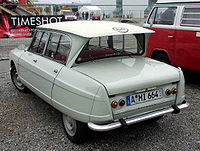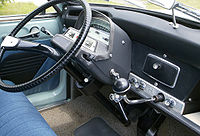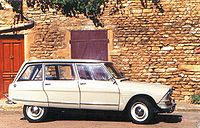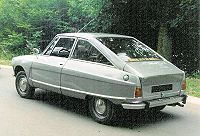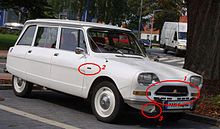- Citroën Ami
-
Citroën Ami 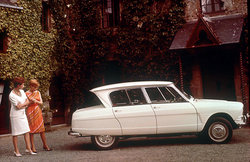
Manufacturer Citroën Production 1961—1978 Assembly Rennes, France[1] (Chartres-de-Bretagne quarter), France Predecessor None Successor Citroën Axel
Citroën VisaClass Supermini Body style 4-door sedan
5-door estateLayout FF layout Engine 602 cc flat-2
1015 cc flat-4Wheelbase 95 in (2,413 mm)[2] Length 154 in (3,912 mm)[2] Width 60 in (1,524 mm)[2] Height 57 in (1,448 mm)[2] Related Citroën 2CV
Citroën FAF
Citroën Dyane
Citroën Méhari
Citroën BijouThe Citroën Ami (French for "friend") is a supermini produced by the French automaker Citroën from 1961 to 1978. The Ami and stablemate Citroën Dyane were replaced by the Citroën Visa and Citroën Axel (the Axel was never sold in the UK).[3] The Ami was for some years the best-selling car model in France. Production totalled 1,840,396 units.
Although not its commercial name, in France the Ami was often referred to as the Citroën 3CV Trois chevaux, or "three horses", CV originally being the initials for "cheval-vapeur" (horsepower), but used here for "chevaux fiscaux" in short. The "cheval fiscal" was a French fiscal unit based on engine size ; smaller CV usually meant economical cars. The 602 cc engine of the Ami was fractionally above the upper limit for the 2 CV taxation class. The 3CV nickname differentiated the car in the market place from the long established Citroën 2CV, but was never applied to the Ami 8, only to the Ami 6.
Contents
Overview
As with Renault 4, Citroën was responding to a market need for a vehicle slightly larger and less utilitarian and rustic than the 2CV. The Ami is a rebodied 2CV with certain mechanical upgrades (particularly a larger engine than the 1950s 2cv), to compensate for the added weight. At launch all the cars were powered by an air cooled 602 cc two-cylinder flat engine which was also offered at extra cost in the 2CV from 1961.
The platform chassis and suspension is similar to the 2CV, being independent all round using leading and trailing arms and coil springs interconnected front to rear. For a detailed suspension description see Citroën 2CV.
The Ami's seats were easily removable. Sales pitches of the Ami included photographs of the seats being used as picnic chairs.
The Ami and the 1961 Ford Taunus were the first vehicles with rectangular (as opposed to round) headlamps.
Market reaction
The car went on sale in France in the Spring of 1961, and already the manufacturer felt obliged to implement some simple upgrades in time for the October Paris Motor Show only six months later. The most visible upgrade involved the replacement of the fixed windows on the rear doors with two part horizontal sliding windows similar to those already fitted on the front doors.[4] Nevertheless, sales in the early years seem to have been disappointingly low. The Ami's first full year of production was 1962, during which only 85,358 of the cars were sold, while the thirteen year old 2CV managed 144,759 sales during the same twelve month period.[4] Although the Ami had a modern body, it shared the aggressively minimalist underpinnings of the older car, and in the market place this made it hard to justify for the Ami a starting price which, at the end of 1961, was 35% higher.[4]
Versions
The Ami 6 sedan is distinguished by an unusual reverse-raked rear window, similar to the "Breezeway" rear screen fitted to the contemporary Mercury Monterey in the US, or the Ford Anglia in the UK. A similar design feature is used on the current three door Citroën C4.
The later Ami 8 saloon has a fastback rear window. It was redesigned by the French car design and bodywork company, Heuliez. Most notable changes were the front part and bonnet and the sloping, rather than inverted, rear window on the saloon. The estate version of the Ami 8 had a similar general appearance to that of the Ami 6 although the later car's tail-lights were integrated into the rear wings.
The Ami Super was a flat-4 variant powered by the engine of the GS and produced between 1973 and 1976. At the launch of the GS, its original flat 4-cylinder air-cooled 1015 cc 55 bhp DIN engine was considered to be underpowered. With surplus engines available, Citroën decided to fit the engine into the Ami 8 in January 1973. The car, which became the Ami Super, then easily reached 140 km / h. From the outside, it had a new front grille and the four additional vents underneath. On the sides of the front wing there was a badge marked 1015 in reference to the new engine. The body is the same but the sheet is thicker (12/10e in mm), which helps the engine to the overall increase in mass. The suspension was equipped with two anti-roll bars. The tires are size 135R15 while Ami retain 125R15. The iodine headlamps are optional. Inside, the gear change is floor mounted, the hand brake is in a central position in place of the gear lever of the Ami 8, a plusher interior differentiates from the Ami 8. The Ami Super was considered too narrow for its engine size. In addition, it was not was too close in exterior looks to the basic Ami 8. As a result, to differentiate the Citroën Ami Super a band of side decorative chrome work and wheels were added for 1974. The Ami Super production reached close to 42,000 in sedan and station wagon by February 1976.
A small series of prototype coupés, the M35 were produced as test vehicles for loyal customers — testing the single-rotor Comotor Wankel engine, as also seen in the NSU Spider. A twin-rotor version of this engine reached production form with the NSU Ro 80 and GS Birotor.
French production
The Ami 6 was the first model to be produced at the new Citroen plant opened in 1961 in the presence of the new president to the south-west of central Rennes. It was later joined at the plant by the Dyane and GS models.
Spanish production
The Ami 6 & Ami 8 were also built by Citroën Hispania in Vigo (Spain) from 1967 to 1978, but they were never called "Ami" because of a legal problem with that name. The equivalences with French built models are:
- Ami 6 berline: never built in Spain.
- Ami 6 break old model (M4 type engine): Citroën Break 3cv.
- Ami 6 break new model (M28 type engine): Citroën Dynam.
- Ami 8 berline: Citroën 8 or C-8.
- Ami 8 break: Citroën 8 Familiar or Citroën Familiar.
Performance
An Ami 6 tested by the British magazine The Motor in 1962 had a top speed of 65.3 mph (105.1 km/h) and could accelerate from 0-50 mph (80 km/h) in 30.3 seconds. A fuel consumption of 53 miles per imperial gallon (5.3 L/100 km; 44 mpg-US) was recorded. The test car cost £823 including taxes on the UK market.[2]
Model Changes in detail
The following table summarises information to distinguish Ami Models.
Production figures
Production of the Ami, all models except M35, is according to the manufacturer's data is 1,840,121 total production. It is divided between the models as follows:
Model Ami 6 Berline/Saloon
Ami 6 Break/Estate
Ami 6 Service Van
Ami 8 Berline/Saloon
Ami 8 Break/Estate
Ami 8 Service Van
Ami Super Berline/Saloon
Ami Super Break/Estate
Ami Super Service Van
Reference Code. AM AM2
AMB AM2B
AMC(2) AMF(2)
AM3
AMB3 AMJB
AMC3 AMJC
AMJF
AMJG
AMJH
Production 483 986
551 880
3 518
342 743 386 582 26 630 24 797
19 222
801
References
- ^ Citroen GS: Citroen build with care (Anglophone brochure for UK market). Slough: Citroen Cars Ltd (UK). August 1976.
- ^ a b c d e "The Citroen Ami 6". The Motor. January 3, 1962.
- ^ "Project VD and Project Y". Citroenvisa.net. http://www.citroenvisa.net/visa1.htm. Retrieved 2010-12-31.
- ^ a b c "Automobilia". Toutes les voitures françaises 1962 (salon Paris oct 1961) (Paris: Histoire & collections) Nr. 19: Page 15. 1200.
External links
Type 1950s 1960s 1970s 0 1 2 3 4 5 6 7 8 9 0 1 2 3 4 5 6 7 8 9 0 1 2 3 4 5 6 7 8 9 Economy car 2CV Off-roader Méhari Supermini LN / LNA Dyane Ami Visa Small family car GS Large family car 11 CV ID / DSpécial / DSuper Executive car 15 CV DS CX Grand tourer SM Categories:- Citroën vehicles
- Subcompact cars
- Vehicles introduced in 1961
- Vehicles with boxer engines
- 1960s automobiles
- 1970s automobiles
Wikimedia Foundation. 2010.

